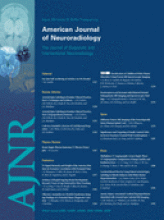We have read with great interest the article of Lv et al1 about the immediate reproducible and reflexive response of the trigeminocardiac reflex (TCR) stimulation by Onyx (ev3, Irvine, Calif) injection during embolization of a tentorial dural arteriovenous fistula in a 53-year-old man. We are the first to have introduced the TCR in neurologic surgery2 and have also pointed out its functional consequence.3 We find it, therefore, interesting that Lv et al1 are now the second after Bauer et al4 to describe the TCR after stimulation of the cranial dura mater.
In this context, it seems to us important to shed light on the somatotopic representation of the cranial dura mater and the major cerebral arteries in the trigeminal ganglion5: Modern tracer methods have investigated the somatotopic organization of meningeal sensation in the gasserian ganglion. The cranial dura mater is supplied by the trigeminal divisions sectorally, in a manner similar to that of the face. Cells in the first trigeminal division are found to innervate the medial aspect of the anterior cranial fossa, the tentorium cerebelli, and the intracranial carotid and the middle cerebral arteries. Neurons associated with the orbital roof are located predominantly in the dorsal and intermediate layers of the second division, whereas the dura of the middle fossa is represented mainly in the dorsal strata of the third division.5
These anatomic relationships in connection with the findings of Lv et al1 give substantial new insights into the hypothesis that the TCR is an “oxygen-conserving reflex” in humans,6 because its initiated pathophysiologic cascade has only the goal of ischemic tolerance. This is additionally supported by the fact that no hitherto-published case of patients with TCR has found any postoperative signs of cerebral ischemia and that no postoperative biomarkers for ischemic tolerance after intraoperative occurrence of TCR can be found.7 However, this separation of the representation from the meningeal cell pool is not sharp enough to avoid TCR but may open the window to treat other neurologic diseases.
In addition, it is well known from the pharmacologic point of view that atropine alone cannot prevent TCR,8 even though it is often given.
References
- Copyright © American Society of Neuroradiology












